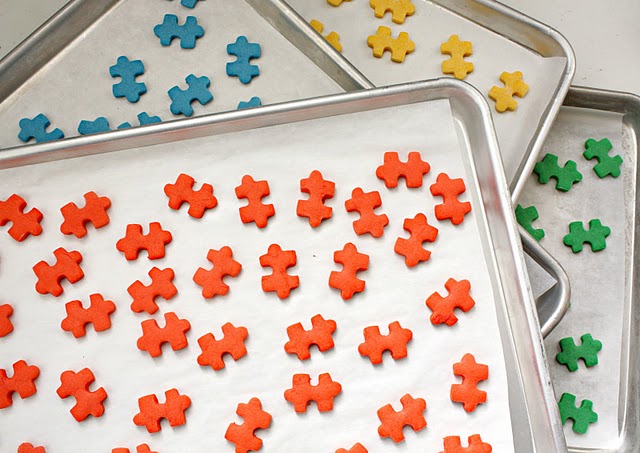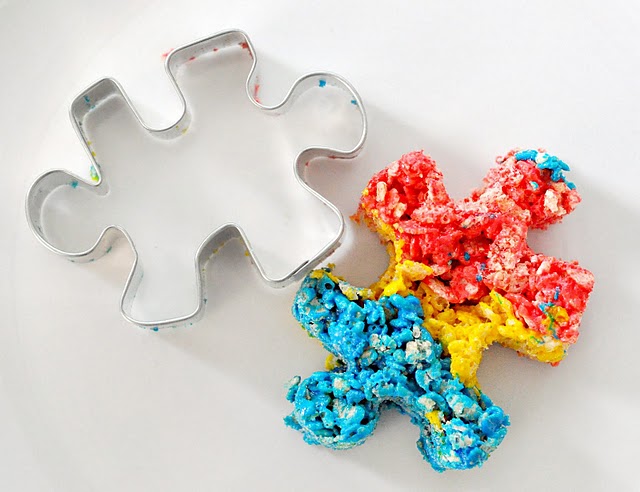Autism Awareness
************GIVEAWAY CLOSED************?
Did you know that April is Autism Awareness Month? It is a month dedicated to increasing awareness and educating the public about autism.
A few weeks ago, I was approached by my friend Mique about doing a special project for Autism Awareness. I personally haven’t had much experience with autism, however, as the mother of an autistic child, this campaign is very near and dear Mique’s heart.
I have to say, I have learned a LOT over the last few weeks and I am glad to share my latest project with you.
With the help of many generous friends, this is what I came up with…

These cookies are very simple, but they still make a big impact.
I chose the idea of cookie jars because they can be used in many ways. I thought they would make great gifts for parents or teachers of autistic children, or a great fundraiser idea because they are very simple and inexpensive to put together.
When I first began thinking about this project, I began scouring the Internet for mini-puzzle cutters. However, I quickly became worried. There just weren’t any available.
Normally, I would just mangle some unsuspecting cutter, but this was a special project and it warranted a special cutter. I immediately knew the perfect people for the job.
I contacted Copper Gifts, and described to them what I had in mind. This is what they made and I couldn’t be more pleased.
To make it even better, they volunteered to donate two dollars from the sale of every mini-puzzle cutter to autism research. I was overwhelmed with their generosity AND as always, completely amazed with the craftsmanship of their cutters.
{click on the photo above to purchase a mini-copper cookie cutter}
To make these cookies, I simply separated my cookie dough into four equal pieces and kneaded in about ten drops of Americolor soft gel paste.
The colors I used were leaf green, royal blue, egg yolk yellow, and tulip red.
After I finished, I wrapped each ball in plastic wrap until I was ready to roll it out.
Notice the little bowl of flour I have on my workstation? This is the secret of mini-cutters. Every few cuts dip it into flour so the dough doesn’t stick to the cutter.
Many mini cookies later, this is where you’ll end up.
Now, in the middle of all this, you might begin to think, “Geez, this is taking forever…” HOWEVER, compared to the time it would take you to flood all these babies, this is nothing!
As I mentioned before, I wanted to come up with a cookie idea that could be both a gift, or something appropriate for a fundraiser, so I asked Mique if she could make some cute little jar labels for both occasions.
This one is a little more casual,
while this one gets straight to the point.
To print your own, head on over to Mique’s blog by clicking on one of the photos. And if you are wondering about the colorful twine, I highly recommend the colorful bunch sampler pack from, The Twinery. It was PERFECT for this!!!
Now, if you aren’t really familiar with how this thing works, USUALLY I do the cookie half, and Mique does the printables and her own little “spin” for the people who might not have the time or desire to make cookies…{although I cannot imagine such a person exists ;)}
But for some reason, I was feeling a little pushy. Maybe it was because I didn’t get to use the larger puzzle cutter myself, or maybe just because I am shooting for worldwide cookie domination. In any case, I really wanted her to do a project that involved COOKIE CUTTERS soooooooooo, I might have been a little bossy, but I am sure glad I was =)
If you don’t have this cutter, you can find it {and tons of other toys} at Sweet Baking and Candy Making Supply {Click on the photo below}
I would also like to send one jar of cookies and a Copper Gifts mini-cutter to one reader. All you have to do to enter is leave a comment telling me about your favorite Autism Awareness Month project, or if you have been personally affected by autism.
Last day to enter is Friday at midnight CST.
Only one entry please, and entries without contact information will not be eligible to win.
I would like to give a special thanks to ?Raymond and Beth Braman of Copper Gifts for working with me on this project. They were AMAZING, and also to The Twinery.
And of course, Mique.
If you would like to donate time or money to autism research, click on the button below.





















I love your idea of making the cookies and the cookie jars. I teach students with autism at the elemetary level. They are of all levels on the spectrum. Each year during Autism Awareness Month in my school, I do something every week to promote autism awareness. Some of the things I do have been to decorate the entire building with autism posters. I also put up a large bulletin board signifying autism awarenss. I do a variety of information programs. I decorate our teacher’s lounge with puzzle pieces and put up mini posters or saying all over the lounge with facts about autism. One year, I did a glueten free project where I had candy jar full of skittles candy and had my co-workers guess the number in the jar. (Along with facts about how gluten can affect those with autism). The person coming closest to the correct # of skittles in the jar won the jar and the candy. I also do announcements each day with autism facts over the intercom and then draw a co-worker’s name. I have purchased a variety of items beforehand promoting autism awareness and the name that is drawn wins that “prize” for the day. (These items have included autism mugs, jewelry, t-shirts, caps, car magnets, pins, ect.) The entire school gets involved in the process of what it is like to experience autism by participating in a sensory overload experiment. Each year I try to add new experiences and ideas that are both fun and factual. This year will be the cookies and the cookie jar for one. Thank you for the great idea!!! Theresa
Pingback: Special Cookies {Autism Awareness Month} « Making Time For Mom
I have two children on the autism spectrum. They love to bake with me and they bring their treats into school to share with friends and teachers. These are so cool, I think we are going to order a cutter or two and make some cookies.
Hi just wondering what size cookie cutter did you use in this project. I pop over to copper gift and they have 3 sizes of the cutter they have the mini tiny and mini cutter . I have that is autistic and I’m thingking if barrowing your idea as a party favor for his 3rd birthday
It is the smallest one they have =)
Hello,
I am a teacher of children with autism and I am getting married next summer! I’m looking to do my favors as a donation for Autism. I would like to give my guests a puzzle piece cookie in addition to this donation. Do you offer any type of group package for events like this?
Thanks,
Heidi Egan
[email protected]
On April 20, I will be running an Autism Awareness Program geared for the Girl Scouts of the Jersey Shore, although, this program is also open to Boy Scouts, and the public should they wish to attend. I have kept the cost of the program at the bare minimum of $3.00 to help cover the cost of the patch and facility use. This event is NOT A FUNDRAISER. I want to give the attendees an idea of “what someone on the Autism Spectrum experiences,” through a hands-on program, as well as promote awareness on the “scout’s level” so they are more accepting of kid’s their own age on the Autism Spectrum and allow for inclusion as much as possible in Scout troops. This program is just the beginning, because in the Fall of 2013, I will be conducting a training for Adult Leaders of both the Girl Scouts and Boy Scouts which will relate to “Scouting With Children On The Spectrum.” I am planning on making planning on making autism puzzle shaped puzzle pieces for snack for everyone in attendance. Autism has touched my life in so many ways. I have 7 children on the autism spectrum and I myself are on the spectrum as well. I have recently been asked by Autism & Scouting to serve on a committee to help prepare training kits for scout leaders who will be working with children on the spectrum and I am so honored to do so. I have only been recently diagnosed, but it has given me an answer to so many questions from my childhood, and I hope that my children and the children I work with don’t suffer from the same unanswered questions I had growing up. Thank God for progress!
PS: My contact information for the contest is as follows — Linda Ann Horvath, [email protected].
I work in a group home with people that have autism. We are having a autism awareness open house and I plan on making these cookies. What a great idea.
Joseph’s Journey
“Putting the puzzle together one piece at a time.”
Joseph Turner is an 11 year old boy who has spent the past 9 years battling autism. Along with autism Joseph also has a heart condition; he had open heart surgery at 3 months old, his leaking valve is still present and will need another surgery in the near future when his heart becomes weak again. Other health issues that Joseph has include: hypoglycemia, food allergies ( Joseph is on a special restricted diet that is very expensive but crucial, if he eats a food that he is allergic to he screams for days in gut-wrenching stomach pain.), asthma (he has had lung surgery), many gastrointestinal/digestive disorders , persistent viral infections and ear infections, feeding disorder (for a long time he suffered with anorexia and would gag on everything he ate), PANDAS, severe anxiety disorder, Tourettes Syndrome, OCD, sensory integration dysfunction, sleeping disorders, and immune disorders.
Joseph spends every day in physical pain due to the extent of his health problems, but he still goes to school and tries very hard to learn even when his body is weak from constant pain and he is exhausted. Joseph was diagnosed with autism when he was 2 years old, the doctor told his mother that her son would never love or show affection, play sports, go to college, or get married. The doctor said that Tara (Joseph’s Mother) needed to give up on all the hopes and dreams parents have for “normal” children and that the best possible thing she could do was plan to place him in an institution.
As you can imagine, these words were devastating, at that point in time there was little information out there about autism so Josephs mom left that doctors appointment very confused, scared, and devastated. Although she wasn’t sure how, Tara knew she could never put her son away in an institution and she was not able to just accept that there was no cure or hope for her sons future. From that moment on Tara began researching, reading every book she could and educating herself on autism. She quickly learned that autism was treatable and was not the hopeless condition Joseph’s former doctor had made it out to be. From that moment on, Tara has dedicated her life and has not stopped fighting for her son and his recovery.
What You Should Know About Autism
Children with Autism may:
Have No Eye Contact.
Have Verbal and Auditory Limitations.
Not Respond To Their Name, or Your Questions.
Seem Deaf or Defiant.
Be Unable To Understand Social Cues.
Have Extreme Sensitivity to Light, Sound, And/or Touch.
Wear Clothing Inside-out To Avoid Tags or Seams against Skin.
Demonstrate Low To No Sensitivity To Pain, or Oversensitivity To Pain.
Have No Fear of Real Danger Or Have Odd Fears.
Take Figurative Language Literally.
“Stim” Or Self-stimulate (Rock Back & Forth, Flap Hands, Flick Fingers, Hyper Laugh, Hum, Etc).
Be Attracted To Water, Traffic, or Have Extreme Obsessions With Certain Ideas, Objects, Places, or People.
Run or Bolt From Stressful Situations.
Enter another Person’s Home without Understanding Consequences.
Be Impulsive or Aggressive When Scared.
Communicate Through a Picture System or Need a Written or Picture Schedule.
Not Be Potty-trained.
Head-bang, Self-bite, Self-hit.
Not Have Toys in His/her Room, or in the
House (May Be More Interested in Lining
Up or Spinning Random Objects.)
Have Extremely Narrow Food Preferences; develop eating disorders, or Ingest Non-food Substances (Pica.)
Be Inflexible To Change.
Have Echolalia: Repeat Something Over & Over.
Walk on Toes.
Autism Facts & Stats
Autism now affects 1 in 50 children
Boys are four times more likely to have autism than girls
About 40% of children with autism do not speak. About 25%–30% of children with autism have some words at 12 to 18 months of age and then lose them. Others might speak, but not until later in childhood.
Autism greatly varies from person to person (no two people with autism are alike)
The rate of autism has steadily grown over the last twenty years.
Co morbid conditions often associated with autism include Fragile X, allergies, asthma, epilepsy, bowel disease, gastrointestinal/digestive disorders, persistent viral infections, PANDAS, feeding disorders, anxiety disorder, bipolar disorder, ADHD, Tourettes Syndrome, OCD, sensory integration dysfunction, sleeping disorders, immune disorders, autoimmune disorders, and neuroinflammation.
Autism is the fastest growing developmental disorder, yet most underfunded.
Insurance does NOT cover Autism.
A 2010 Danish Study found that the mortality risk among those with autism was nearly twice that of the general population
Children with autism can and do progress – early intervention is key.
Autism is treatable, there is Hope.
“Hopes, Dreams and Fears”
Over the past 8 years, the Turner’s have had many ups and downs struggling to find the right medical treatment and therapy methods that worked for Joseph. They have tried a lot of treatments that failed or showed little to no improvement. Finally in 2007, Tara met Jane; Jane is the founder of a private ABA Educational Facility school here in North Carolina that specializes in teaching children with autism, like Joseph and other special needs as well. Until Joseph began attending school here he was nonverbal, was not toilet trained, and did not have the motor skills to even hold utensils such as a fork or spoon to eat his meals. Jane and her staff are truly committed to teaching these children the basic tasks of everyday living along with the knowledge to read , write, speak and function in today’s society. Joseph can now speak full sentences, sit down at a restaurant with his parents and older brother, tell you when he is hungry, make choices for his self, and even plays with other children. He is now in cub scouts, is able to understand and listen better, and was actually invited and to his first birthday party this year! Words cannot describe the amount of progress that the Turner’s have seen Joseph make in the past few years since attending Jane’s program in combination with finding supportive medical doctors and his gluten free diet. The best part is that Joseph actually loves school and is excited about learning and spending time with his teachers and friends. Tara and her husband also know that Joseph is safe at his school, accepted and loved by his teachers and peers, and is getting the best education he could possibly have.
Joseph is improving with leaps and bounds, but he still needs intensive amounts of therapy and treatment to get him to where he needs to be. Now that the Turner’s have found the right therapy that has already worked many miracles in Joseph’s life, it really is almost too good to be true. Unfortunately, insurance does not cover anything that pertains to autism. The cost of Joseph’s education is 23 dollars an hour for 30 hours a week and the Turners pay this out of pocket. Both parents work very hard to support their children and to pay for the extent of Joseph’s needs including therapy and the many other special things required to help Joseph recover and feel better including his medical bills and the items needed for his special dietary needs.
Needless to say, The Turners are struggling; they are on the verge of losing everything and worry how they will be able to provide for the extent of Joseph’s needs so he can get well. As with any parent, if you see your child suffering and you finally find a way to make it better it is second nature to exhaust all efforts to continue what is working. Tara’s constant worry and biggest fear is what will happen to Joseph if something were to ever happen to her and her husband. Like the first doctor that diagnosed Joe’s autism, most people will tell you that an institution is the best thing you can do. The thought of your child with special needs ending up in an institution one day brings about as much peace of mind as a parent who knows their child is going to prison. Tara is not bothered by the fact that Joseph has autism, but she does want him to have a safe and happy life. Her hopes and dreams for Joseph are that with enough treatment and support he will one day be well enough to be a member of society and never need to be institutionalized.
Tara has good reason to worry about Joseph’s future and safety; her fears consist of worrying about bodily injury or harm, bullying, and even extend to death. Since children who have autism have a hard time speaking or listening but do not typically display any physical defects, many people interpret their actions as bad behavior. Most children with autism have severe issues with anxiety and something as simple as an outing to Wal-Mart can traumatize them. There are many issues on safety and other reasons why Tara worries for Joseph, here are some facts and statistics to consider:
Overall Mortality
In 2010, Danish researchers found that the mortality risk among the autism population is twice as high as the general population
In 2009, a California research team found elevated deaths in autism and attributed it to several causes, including seizures and accidents such as suffocation and drowning
Wandering/elopement
Roughly half, or 48%, of children with an ASD attempt to elope from a safe environment, a rate nearly four times higher than their unaffected siblings
In 2009, 2010, and 2011, accidental drowning accounted for 91% total U.S. deaths reported in children with an ASD ages 14 and younger subsequent to wandering/elopement.
More than one third of ASD children who wander/elope are never or rarely able to communicate their name, address, or phone number
Two in three parents of elopers reported their missing children had a “close call” with a traffic injury (Joseph has actually jumped out of the car; Tara managed to reach him just before he made it to the highway).
32% of parents reported a “close call” with a possible drowning
62% of families of children who elope were prevented from attending/enjoying activities outside the home due to fear of wandering
40% of parents had suffered sleep disruption due to fear of elopement
Children with ASD are eight times more likely to elope between the ages of 7 and 12 than their typically-developing siblings
Half of families with elopers report they had never received advice or guidance about elopement from a professional
Bullying
65% of parents reported that their children with autism had been victimized by peers in some way within the past year
47% reported that their children had been hit by peers
50% reported them to be scared by their peers
9% were attacked by a gang and hurt in the private parts
12% indicated their child had never been invited to a birthday party
15% were almost always picked last for teams
10% ate alone at lunch every day
Sexual Abuse
Additionally, the U.S. Department of Justice’s National Crime Victimization Survey, the country’s largest and most reliable crime study, reports that every two minutes a person is sexually victimized in the United States—and the numbers for individuals with disabilities are even higher.
A study done in Nebraska of 55,000 children showed a child with any type of intellectual disability was four times more likely to be sexually abused than a child without disabilities such as autism.
Saving Joseph
As you can see from some of the statistics listed above; autism is not only very lonely and difficult disorder for the individual who has it, it can also be dangerous. Tara knows she is very blessed that Joseph is still here, but she cannot help but be concerned for his future. Tara has fought and searched endlessly to save her son, I know this because I am Joseph’s aunt and Tara’s sister. I am writing this in an effort to plead for help for this family and most importantly to rescue Joseph. I look into Joseph’s sweet dark brown eyes and I see a sad little boy who is lost inside this lonely, painful, and confusing world of autism. Joseph is the most incredible person I have ever met, many of his doctors have said that we couldn’t make it one day in his shoes. He is so sweet and loving, it breaks my heart into pieces to watch him suffer the way that he does and know I do not have the finances to help. I have watched people make rude remarks in from of Joseph as if he couldn’t hear them, or even completely ignore his presence in a room. He is a precious little boy who has been treated like he didn’t exist more times than I can count. I have watched Santa Claus at a shopping mall tell my sister not to bring him back until he could behave better just because he put his hands over his ears (stiming) and could not respond to answer questions. I see all the rude stares he gets just because he is different than typical children and I can’t imagine how he must feel. I understand that the economy is not doing very well these days and money is very tight for everyone, but if you do consider giving you are doing a greater deed then you could ever envision. Joseph isn’t asking for much, just a chance to have happiness, be accepted and to live the life he deserves to live. I have no doubt in my mind that if given that chance, Joseph will continue to amaze us with his achievements, conquer autism, and never spend one day in an institution.
If Joseph could talk this is what he would want you to know.
1. Please know that I am a child.
My autism is only one part of which I am, not all of who I am. Are you just one thing, or are you a person with thoughts, feelings, preferences, ideas, talents, and dreams? As an adult, you have control over how you define yourself. If you want to single out one characteristic, you can make that known. As a child, I am still unfolding. Neither you nor I yet know what I may be capable of. If you think of me as just one thing, you run the danger of setting up an expectation that may be too low. And if I get a sense that you don’t think I “can do it,” my natural response will be, why try?
2. Please know that my senses are out of sync.
This means that ordinary sights, sounds, smells, tastes, and touches that you may not even notice can be downright painful for me. My environment often feels hostile. I may appear withdrawn or belliger¬ent or mean to you, but I’m just trying to defend myself. Here’s why a simple trip to the grocery store may be agonizing for me. My hearing may be hyper acute. Dozens of people jabber at once. The loudspeaker booms today’s special, Music blares from the sound system. Registers beep and cough, a coffee grinder chugs. The meat cutter screeches, babies wail, carts creak, the fluorescent lighting hums. My brain can’t filter all the input and I’m in overload! My sense of smell may be highly sensitive. The fish at the meat counter isn’t quite fresh, the guy standing next to us hasn’t showered today, the deli is handing out sausage samples, the baby in line ahead of us has a poopy diaper, and they’re mopping up pickles on aisle three with ammonia. I feel like throwing up. And there’s so much hitting my eyes! The fluorescent light is not only too bright, it flickers. The space seems to be moving; the pulsating light bounces off everything and distorts what I am seeing. There are too many items for me to be able to focus (my brain may compensate with tunnel vision), swirling fans on the ceiling, so many bodies in constant motion. All this affects how I feel just standing there, and now I can’t even tell where my body is in space.
3. Distinguish between won’t (I choose not to) and can’t (I am not able to).
It isn’t that I don’t listen to instructions. It’s that I can’t understand you. When you call to me from across the room, I hear “*&^%$#@, Jordan. #$%^*&^%$&*.” Instead, come over to me, get my attention, and speak in plain words: “Jordan, put your book in your desk. It’s time to go to lunch.” This tells me what you want me to do and what is going to happen next. Now it’s much easier for me to comply.
4. I’m a concrete thinker. I interpret language literally.
You confuse me by saying, “Hold your horses, cowboy!” when what you mean is, “Stop running.” Don’t tell me something is “a piece of cake” when there’s no dessert in sight and what you mean is, “This will be easy for you to do.” When you say, “It is pouring cats and dogs,” I see pets coming out of a pitcher. Tell me, “It’s raining hard.”
Idioms, puns, nuances, inferences, metaphors, allusions, and sarcasm are lost on me.
5. Listen to all the ways I’m trying to communicate.
It’s hard for me to tell you what I need when I don’t have a way to describe my feelings. I may be hungry, frustrated, frightened, or confused but right now I can’t find those words. Be alert for body language, withdrawal, agitation or other signs that tell you something is wrong. They’re there. Or, you may hear me compensate for not having all the words I need by sounding like a little professor or movie star, rattling off words or whole scripts well beyond my developmental age. I’ve memorized these messages from the world around me because I know I am expected to speak when spoken to. They may come from books, television, or the speech of other people. Grown-ups call it echolalia. I may not under¬stand the context or the terminology I’m using.
7. Focus and build on what I can do rather than what I can’t do.
Like any person, I can’t learn in an environment where I’m con¬stantly made to feel that I’m not good enough and that I need fixing. I avoid trying anything new when I’m sure all I’ll get is criticism, no matter how “constructive” you think you’re being. Look for my strengths and you will find them. There is more than one right way to do most things.
8. Help me with social interactions.
It may look like I don’t want to play with the other kids on the playground, but it may be that I simply do not know how to start a conversation or join their play. Teach me how to play with others. Encourage other children to invite me to play along. I might be delighted to be included.
I do best in structured play activities that have a clear beginning and end. I don’t know how to read facial expressions, body language, or the emotions of others. Coach me. If I laugh when Emily falls off the slide, it’s not that I think it’s funny. It’s that I don’t know what to say. Talk to me about Emily’s feelings and teach me to ask, “Are you okay?”
9. Identify what triggers my meltdowns.
Meltdowns and blow-ups are more horrid for me than they are for you. They occur because one or more of my senses has gone into overload, or because I’ve been pushed past the limit of my social abilities.
Remember that everything I do is a form of communication. It tells you, when my words cannot, how I’m reacting to what is happening around me. My behavior may have a physical cause. Food allergies, sensi¬tivities, sleep problems, gastrointestinal problems, and all of my other health issues can all affect my behavior. Look for signs, because I may not be able to tell you about these things.
10. Love me unconditionally.
I didn’t choose to have autism, remember that it’s happening to me, not you. Without your support, my chances of growing up to be successful and independent are slim. With your support and guidance, the possibilities are broader than you might think.
View my autism as a different ability rather than a disability. Look past what you may see as limitations and see my strengths. I may not be good at eye contact or conversation, but have you noticed that I don’t lie, cheat at games, or pass judgment on other people? I rely on you. All that I might become won’t happen without you as my foundation. Be my advocate, be my guide, love me for who I am, and we’ll see how far I can go
please email me at [email protected] or call me at336-870-2391
My son is autistic I would love a cookie cutter I love the idea you came up with… my sister and I are making shirts for the Autism Speaks Walk in May if you would like to donate just let me know
I love these!
Hello, absolutely love these!! Wondering what type of cookie dough did you use? I tried with sugar cookie dough and they spread out and do not look like yours at all : (
Thanks
Are the cutters still available? I work for an agency in Windsor Ontario Canada and we provide a summer program for kids with autism. We host a pasta dinner fund raiser in April for the program and these would be fun to make. Would love to buy them.